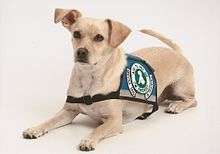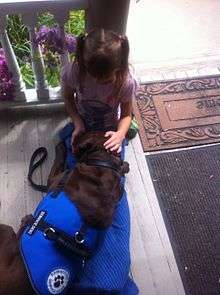Psychiatric service dog

A psychiatric service dog is a specific type of service dog trained to assist their handler with a psychiatric disability, such as post-traumatic stress disorder, schizophrenia, depression, anxiety, and bipolar disorder .[1][2]
Although assistance dogs have traditionally helped people with disabilities such as blindness or more recently deafness or mobility disabilities, there is a wide range of other disabilities that an assistance dog may be able to help with as well, including psychiatric disabilities.[3][4]
Training


Like all assistance dogs, a psychiatric service dog is individually trained to do work or perform tasks that mitigate their handler's disability.[5] Training to mitigate a psychiatric disability may include providing environmental assessment (in such cases as paranoia or hallucinations), signaling behaviors (such as interrupting repetitive or injurious behaviors), reminding the handler to take medication, retrieving objects, guiding the handler from stressful situations, or acting as a brace if the handler becomes dizzy.[3][4][5]
Psychiatric service dogs may be of any breed or size suitable for public work. Many psychiatric service dogs are trained by the person who will become the handler—usually with the help of a professional trainer. Others are trained by assistance or service dog programs. Assistance dog organizations are increasingly recognizing the need for dogs to help individuals with psychiatric disabilities, and there are even organizations dedicated specifically to supporting psychiatric service dog handlers.[6]
Accessibility
In the United States, the Americans with Disabilities Act defines a disability as "a physical or mental impairment that substantially limits one or more of the major life activities of such individual,"[7] and therefore allows handlers of psychiatric service dogs the same rights and protections afforded to those with other types of service animals.[2] Service dogs, including psychiatric service dogs, are allowed to accompany their handler in any location that is normally accessible to the public whether or not health codes or business policy normally would allow a dog to enter, provided the dog behaves properly and does not interfere with normal operations (e.g. barking, biting, defecating, or obstructing other people) or pose a direct threat to the safety of others.
An alternative to a psychiatric service dog is an emotional support animal, which may or may not have specific training related to the handler's disability, but provides companionship and emotional support. They do not qualify as service animals in the United States, though they do qualify for several exceptions in housing and air travel.
The Fair Housing Act also allows tenants that have service animals or emotional support animals to stay in housing that does not allow pets.[8] Some individual state laws may also provide additional guidelines or protection.
The Air Carrier Access Act also permits psychiatric service dogs and emotional support animals to be permitted to travel in the cabin when accompanied by a person with a disability. [9]
Social issues with accessibility
People with psychiatric service dogs are often faced with several problems that other service dog handlers typically do not experience. While guide dogs for the blind and hearing-impaired and helper dogs for people who use wheelchairs are well-known to the public, dogs for psychiatric conditions are not. Further adding to this issue is that many people with psychiatric conditions do not appear to have anything externally wrong with them, and because of the heavy social stigma of mental illness, the handler may be reluctant to explain their condition or the dog's trained tasks even in the vaguest of terms. In addition, the dogs can be any size (even toy breeds) depending on their trained task, yet there is a common public misconception that all service dogs are medium or large breeds. Any of these issues can lead to other people inappropriately impugning the dog's status or pressing the handler to divulge medical information about themselves.
See also
- Autism service dog
- Guide dog
- Hearing dog
- Medical response dog
- Mobility assistance dog
- Seizure response dog
- Assistance dog
Footnotes
- ↑ Esnayra J (July 2007). "Help from man's best friend. Psychiatric service dogs are helping consumers deal with the symptoms of mental illness". Behav Healthc 27 (7): 30–2. PMID 18027616.
- 1 2 Service Dog Central - Psychiatric Service Dogs Retrieved on August 17, 2007.
- 1 2 Psychiatric Service Dog Society - Psychiatric Service Dog Tasks (retrieved from Internet Archive)
- 1 2 International Association of Assistance Dog Partners - Service Dog Tasks for Psychiatric Disabilities Retrieved on January 31, 2007.
- 1 2 Service Dog Central - Psychiatric Service Dog Tasks
- ↑ Psychiatric Service Dog Partners Retrieved on August 5, 2012.
- ↑ Americans with Disabilities Act of 1990 Retrieved on January 31, 2007.
- ↑ Questions and Answers about Fair Housing
- ↑ Air Travel with an Assistance Dog Retrieved on April 5, 2010.